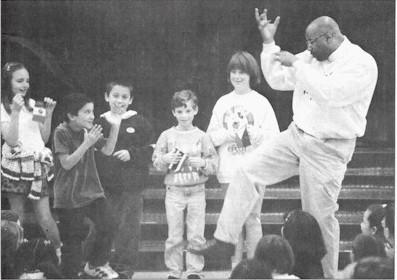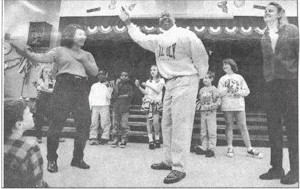|
Colorful Flags tries
to Break the Ice

RENFORD REESE,
right, and third grader Frank Ortega, second from left, striking fighting
poses Thursday during Colorful Flags program at Cedargrove Elementary
School in Covina
|
| Students
shown how short phrases in other languages bridge gap |
By Diane Brown
Staff Writer
Covina - Can we all get along?
The problem with
building positive ethnic relationships is that people don't
break the ice, says Californian.
Polytechnic University at Pomona professor
Renford Reese.
He spent Thursday morning helping students
at Cedargrove Elementary School practice ice-breakers during
two 45 minute presentations of his language-based Colorful Flags
program.
Words spoken in a person's native or
first language reduce mistrust and stimulate cultural curiosity,
Reese says.
As children held international flags
as props, the Colorful Flags director drilled them over phrases
such as "What's your name," "Please," and
'"Thank you," in the five most spoken non-English
languages at the school Spanish, Arabic, Cantonese, Mandarin
and Tagalog.
Reese asked a third-grader to teach
her school mates how to say "Hello.
|
How are
you" in Tagalog, the native language of the Philippines and
one of two languages spoken in her home.
"Kamusta Ka Na" said student
Alexandra Sam speaking the language at her school for her first
time.
"It was exciting," Sam, 8,
said of the experience. "It made me feel better to know that
other people can speak my language and I won't be ashamed of my
culture."
That's the kind of positive experiences
that are important in the development of better race relations,
Reese said.
"Kids from different ethnic backgrounds
are empowered by this," the professor said.
In turn, their listeners became more
curious and hopefully will venture out to learn additional foreign
phrases, Reese said.
The Cal Poly Pomona political science
professor grew up in an English-speaking Caucasian/African-American
community near Atlanta, but now speaks conversational phrases
in 15 languages, he said.
Throughout Thursday's lively presentations,
Reese, students and teachers used animated body and hand movements
that reflected inflections of their voices. |
|

TEACHER
Helen Oh, left, can win $1 if she can correctly pronounce "please"
in Tagalog.
|
"If
was pretty cool," said Marty Critchfield, 10. At the invitation
of a Cal Poly Pomona administrator, Reese said he relocated the
program's headquarters from the University of Southern California
to Cal Poly Pomona last summer.
Cedargrove is one of five East San Gabriel
Valley schools using the program's audio tapes and video tapes,
and phonetic cards, available in 25 languages, officials said.
Twenty-four teachers at the Covina school
more than half the staff, has used the five month program since
January, Assistant Principal Carole Lupica said. PTA funding has
paid for the school's portion of program expenses, about $5 per
classroom, she said. |
"If
you can make a connection with someone from a different culture,
you build respect," said Cedargrove teacher Linda Lemon,
adding her third grade students love the program.
Reese's program concepts grew out of
the death of Latasha Harlins, an African-American youth shot to
death in 1991 by a Korean merchant dispute over a bottle of juice.
"I know it's more complex than this,
but what if (Harlins) had said 'An Yong Ha Sae Yo' when she walked
into that store?" Reese said.
As simple as it sounds, '*Hello. How
are you doing?" spoken in a person's native language can
diffuse racial mistrust, according to the political science instructor.
|
Back to Articles
|

